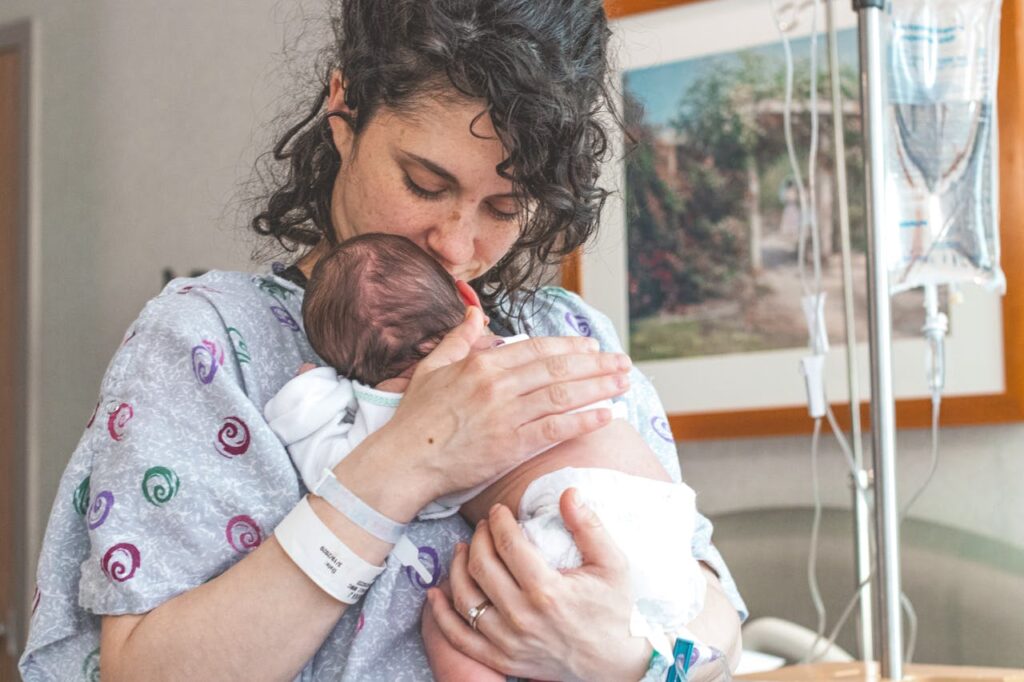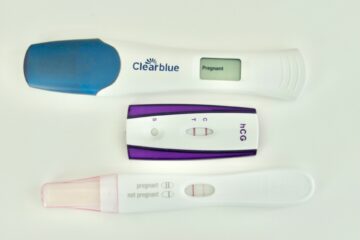The postpartum recovery period, often referred to as the “fourth trimester,” is a time of significant physical and emotional healing for new mothers. While every woman’s recovery experience is unique, the general timeline for postpartum recovery can vary depending on factors such as the type of delivery (vaginal or cesarean), any complications during birth, and the mother’s overall health.
In this article, we’ll explore the typical recovery timeline after giving birth, what to expect during each stage, and tips for promoting a healthy recovery.

General Postpartum Recovery Timeline
1. Immediate Postpartum (First 24 Hours)
The first 24 hours after giving birth are crucial for both the mother and baby. During this time, the mother is monitored closely for any signs of complications, such as excessive bleeding or infection. The uterus begins to contract to shrink back to its pre-pregnancy size, and the body starts the healing process.
- Vaginal Delivery: After a vaginal birth, the perineal area (the area between the vagina and anus) may be sore, especially if there were tears or an episiotomy. Some women may also experience swelling and discomfort.
- Cesarean Delivery: For mothers who had a cesarean section, the first 24 hours are focused on managing pain and monitoring the incision site for signs of infection.
2. First Week Postpartum
The first week postpartum is often the most challenging as the body continues to heal from the physical demands of childbirth. Here’s what to expect:
- Lochia: Vaginal bleeding, known as lochia, is common after both vaginal and cesarean deliveries. This bleeding can last for several weeks and is similar to a heavy period in the first few days.
- Uterine Contractions: The uterus continues to contract, which can cause cramping, especially during breastfeeding. These contractions help the uterus return to its pre-pregnancy size.
- Perineal Discomfort: If you had a vaginal delivery, you may experience pain or discomfort in the perineal area. Ice packs, sitz baths, and pain relievers can help ease this discomfort.
- Cesarean Recovery: For mothers who had a cesarean section, the incision site may be sore, and it’s important to avoid heavy lifting or strenuous activity to allow the wound to heal.
3. First 6 Weeks Postpartum
The first six weeks after giving birth are considered the primary recovery period. During this time, the body continues to heal, and many of the initial postpartum symptoms begin to subside.
- Vaginal Healing: For vaginal deliveries, any tears or episiotomy stitches should heal within this time frame. However, some women may experience lingering discomfort or pain during intercourse.
- Cesarean Healing: The cesarean incision should be mostly healed by six weeks, but some women may experience numbness or tenderness around the scar for several months.
- Hormonal Changes: Hormonal fluctuations can cause mood swings, night sweats, and changes in hair and skin. These changes are normal but can be challenging to manage.
- Breastfeeding: If you’re breastfeeding, your body will continue to produce milk, and you may experience engorgement or sore nipples. Lactation consultants can help with any breastfeeding challenges.
4. 6 to 12 Weeks Postpartum
By six to twelve weeks postpartum, many women start to feel more like themselves again, though full recovery can take longer. At this point, most women have their first postpartum check-up with their healthcare provider to assess their physical and emotional health.
- Return to Normal Activities: Many women are cleared to resume normal activities, including exercise and sexual intercourse, after six weeks. However, it’s important to listen to your body and not rush the process.
- Pelvic Floor Recovery: Some women may experience pelvic floor weakness after childbirth, which can lead to issues such as urinary incontinence. Pelvic floor exercises, such as Kegels, can help strengthen these muscles.
5. 3 to 6 Months Postpartum
While many women feel significantly better by three months postpartum, full recovery can take up to six months or longer, especially for those who had a cesarean section or experienced complications during childbirth.
- Physical Recovery: By this time, most of the physical symptoms of childbirth, such as bleeding and cramping, should have subsided. However, some women may still experience fatigue, back pain, or pelvic discomfort.
- Emotional Recovery: The emotional adjustment to motherhood can take time, and some women may experience postpartum depression or anxiety. It’s important to seek support from a healthcare provider if you’re struggling with your mental health.
6. 6 Months to 1 Year Postpartum
For many women, it can take up to a year to fully recover from childbirth, both physically and emotionally. This is especially true for women who had a cesarean section, experienced complications, or are dealing with postpartum depression.
- Cesarean Recovery: For cesarean deliveries, the scar will continue to heal and fade over time, but some women may experience numbness or discomfort around the incision site for up to a year.
- Hormonal Balance: Hormones may take several months to fully stabilize, especially if you’re breastfeeding. Some women experience irregular periods or changes in their menstrual cycle during this time.
- Return to Pre-Pregnancy Fitness: It’s important to remember that every woman’s body is different, and it may take time to regain pre-pregnancy strength and fitness. Focus on gradual, gentle exercise and consult your healthcare provider before starting any intense workout routine.
Factors That Can Affect Postpartum Recovery
While the general timeline for postpartum recovery is similar for most women, several factors can influence how long it takes to recover after giving birth:
1. Type of Delivery
- Vaginal Delivery: Recovery from a vaginal delivery is typically faster than from a cesarean section. However, if there were complications, such as tearing or an episiotomy, recovery may take longer.
- Cesarean Section: Recovery from a cesarean section generally takes longer because it is a major abdominal surgery. Most women need at least 6 to 8 weeks to recover from a cesarean, and full recovery can take several months.
2. Complications During Birth
If there were complications during childbirth, such as excessive bleeding, infection, or a difficult delivery, recovery may take longer. In some cases, women may need additional medical care or physical therapy to aid in their recovery.
3. Overall Health
A woman’s overall health before and during pregnancy can affect how quickly she recovers after giving birth. Women who are in good physical health and have a strong support system may recover more quickly than those who experience health issues or lack support.
4. Emotional Health
Postpartum depression and anxiety can significantly impact a woman’s recovery. It’s important to seek help if you’re experiencing symptoms of depression, anxiety, or overwhelming feelings of sadness or hopelessness.
Tips for a Healthy Postpartum Recovery
While the recovery process takes time, there are several steps new mothers can take to promote healing and well-being during the postpartum period:
1. Rest as Much as Possible
Sleep deprivation is common for new mothers, but rest is essential for healing. Try to sleep when the baby sleeps, and don’t hesitate to ask for help with nighttime feedings or household chores.
2. Stay Hydrated and Eat Nutritious Foods
Eating a balanced diet rich in fruits, vegetables, lean proteins, and whole grains can help your body recover from childbirth. Staying hydrated is also important, especially if you’re breastfeeding.
3. Take Care of Your Perineal Area
If you had a vaginal delivery, keeping the perineal area clean and using ice packs or sitz baths can help reduce discomfort and promote healing.
4. Manage Pain
Whether you had a vaginal delivery or a cesarean section, it’s important to manage pain effectively. Over-the-counter pain relievers, such as ibuprofen or acetaminophen, can help, but consult your healthcare provider if you need stronger medication.
5. Seek Emotional Support
The postpartum period can be emotionally challenging, and it’s important to seek support from your partner, family, friends, or a therapist. If you’re experiencing symptoms of postpartum depression or anxiety, don’t hesitate to reach out to a healthcare provider.
6. Start Gentle Exercise When Ready
Once your healthcare provider gives you the green light, start with gentle exercises, such as walking or postpartum yoga, to help regain strength and improve mood. Pelvic floor exercises, such as Kegels, can also help with recovery.
Conclusion
Postpartum recovery is a gradual process that can take anywhere from a few weeks to several months, depending on the type of delivery and individual circumstances. While the physical healing process is important, it’s equally essential to prioritize emotional well-being and seek support when needed. By understanding the typical recovery timeline and taking steps to promote healing, new mothers can navigate the postpartum period with confidence and care.
FAQ
- How long does it take to recover from a vaginal delivery?
- How long does it take to recover from a cesarean section?
- When can I resume normal activities after giving birth?
- What are the signs of postpartum depression?
- How can I speed up my postpartum recovery?


0 Comments